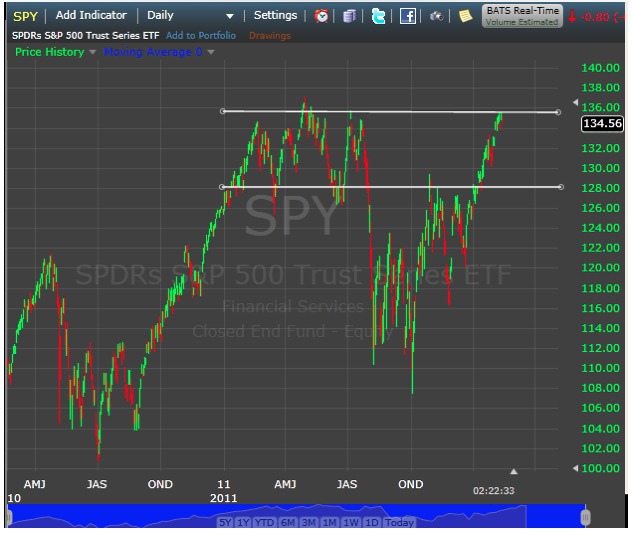
What are investors to make of the endless parade of events on the calendar that we’re told have the potential to move markets? We’ve survived the fiscal cliff, sequestration, talk of Fed tapering, threats of Syrian intervention, an election in Germany, a shake-up in Italian politics. Of course, stateside, we now have the government shutdown and stare head-on now at the spectacle of the debt-ceiling circus.
Washington is dysfunctional, but the market knows it. The geopolitical situation in the Middle East is beyond complicated, and the world is hampered by too much debt, with economies everywhere still fragile. These facts, too, have been digested.
Granted, the latest debacle over the shutdown and looming debt ceiling question have taken the S&P 500 down from its recent high in mid-September.
The market has clearly not focused on the things that bother the rest of us. Perhaps it is drunk on cheap money and recklessly oblivious to the world’s problems, but maybe it knows something we don’t know about the future?
We may think we know if the market is overvalued or undervalued, but that information may be of little practical use to us in the relative short run. Often the market moves in a direction that is divorced from fundamental reality.
As an investor, I can control my investment process, where I invest, when and with how much money. I can reject companies for not having long enough product cycles, for not having a strong enough balance sheet, for not being shareholder friendly, for not being profitable enough, for not having a competitive edge, and for making bone-headed decisions with shareholder capital.
Investing is thinking through the sustainability of cash flows being generated by the assets I own and determining how much I am willing to pay for that cash flow.
I can also control my mind-set. The stock market is not cheap and it would not be unusual for this pullback to turn nastier. Prepare yourself psychologically for some downside volatility.
Markets respond to surprises. Known risks, by definition, are not a surprise. Markets will diverge from a major trend only when an event happens that catches the market off-guard. The universe of great businesses selling at good prices has narrowed considerably. Equally, the number of good businesses selling at great prices is lower still. But for the long-term investor, there remains a market of stocks that present reasonable valuations at current levels.
I believe markets in Singapore and Western Europe currently offer better bargains than stocks here the U.S. Nonetheless, and despite our bias in favor of small to mid-cap firms, three American names in particular stand out for great value and are priced at good entry points for accumulating shares.
All three of these companies are lower in price now than they were a year ago. I like them because they pass my investment tests. All of them have long product cycles, strong balance sheets, high profitability, a competitive edge, and a respect for shareholder capital.
Barring economic armageddon, I believe their businesses, on a per share basis, will be more valuable down the road than they are today in real terms. I am aware some readers will look at these familiar names and think at least two of them are obvious investment picks. Our response is that sometimes underscoring the obvious, that these are great businesses selling at good prices, can be of value. Particularly in a stock market that is, by historical measures, expensive.
IBM – Big Blue meets the Big Data challenge
International Business Machines (NYSE: IBM) sells for 12X earnings in a market that sells for 18X. It has a free cash flow yield of 9%. The stock is down about 11% in the past year but its dividend has grown 12%. IBM’s product cycle is long and they benefit from a blue-chip balance sheet. Historically IBM has enjoyed net profit margins in the mid-teens and return on invested capital of 20%.
IBM has significant economies of scale working in its favor and most of the lower margin commodity type businesses have been jettisoned: 86% of its revenues are derived from value-added services and software solutions. The barriers to entry for potential competitors in their core business are high.
I think the longer term future for IBM could be better than the market expects. The past decade has been about re-positioning the business to deal effectively with marketplace realities and opportunities. Who better than “Big Blue” to meet the challenges and opportunities presented by the emergence of “Big Data?”
But the surprise could be around products in development: cognitive computer chips that learn without programming, being able to store memory on just 12-atoms, quantum computing, etc. Perhaps not so surprising when you recognize that for 20 years straight IBM has ranked #1 in U.S. patent issuance.
I believe something significant could come from IBM’s research. If not, the fact remains: IBM has an entrenched position in its marketplace and has grown earnings per share over the past decade by 12% a year, on average, through a combination of efficiencies, share buybacks and modest growth.
Mosaic – More and Better Food, Including Meat
The long-term investment case for fertilizer maker Mosaic (NYSE: MOS) is pretty simple. It is a direct bet that the world’s population will continue to grow and that ever increasing numbers of people will continue to add meat to their diet.
In my opinion, Mosaic is a quality business (with a Cargill pedigree) and they own critical assets required by the global agricultural value chain. The crop nutrient and animal feed business is cyclical and seasonal. Both raw materials costs and the prices Mosaic receives for their products are volatile.
So investors should expect a high degree of lumpiness in their results. Mosaic enjoys low debt levels and has net cash of some $3 billion versus a market cap value of roughly $19 billion. Despite volatility in results, book value has doubled over the past 5 years and is now $32. The current P/E ratio using the Ben Graham method is 11X. The stock price is down 24% in the past year and the dividend yield of 2.2% potentially has plenty of room to grow.
In the short-run we recognize Mosaic’s share price may be cheap for a reason (uncertainty over potash prices) but as long-term investors, we see no trend that challenges our thesis that people in the developing world will continue to demand more and better food, including meat.
Coca-Cola – Second to None
Coca-Cola Company (NYSE: KO) is the world’s largest beverage company. Coke’s greatest asset is a distribution network that is second to none. The dividend of nearly 3% grows every year, doubling since 2005, and paid without interruption since 1893.
The P/E of 19X may not look like a bargain, but it is at its lowest relative valuation for more than a decade. Coca Cola has been methodical when it comes to reinvestment of cash flow, share buybacks and dividend increases. Return on invested capital has historically been in the 18-20% range.
Coca-Cola has experienced earning per share growth of 9% over the past decade but recently has been penalized by the market for its strong exposure to the emerging markets. The stock is down slightly from a year ago. At some point, emerging markets exposure should once again be seen as a good thing.
Photo Credit: Alice Bartlett
The investments discussed are held in client accounts as of September 30, 2013. These investments may or may not be currently held in client accounts. The reader should not assume that any investments identified were or will be profitable or that any investment recommendations or investment decisions we make in the future will be profitable. Past performance does not guarantee future results.



